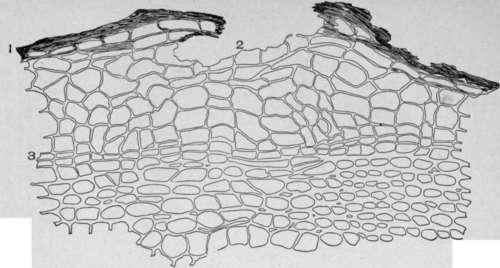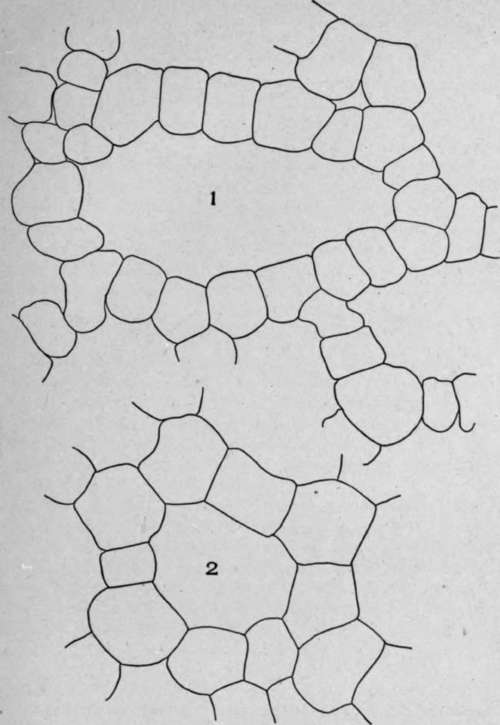Aerating Tissue. Continued
Description
This section is from the "Histology of Medicinal Plants" book, by William Mansfield. Also see Amazon: Histology of Medicinal Plants.
Aerating Tissue. Continued
Lenticels
Lenticels are small openings occurring in the bark of plants. The lenticels bear the same relationship to the stem that the stomata do to the leaves. Lenticels, like stomata, have a threefold function - namely, exchange of gases in photosynthesis, in respiration, and the giving off of water.
Lenticels are macroscopically as well as microscopically important. When unmagnified the lenticels are circular, lens-shaped, or irregular in outline. They are arranged in parallel longitudinal lines or parallel transverse lines, or they are irregularly scattered. The latter is the usual arrangement. In most cases they are elevated slightly above the surface of the bark. In root barks particularly the lenticels stand out prominently from the surface of the bark and in many cases appear stalked.
The color of the lenticels differs greatly in the different plants. In acer spicatium they are brown; in witch-hazel they are gray; in xanthoxylium they are yellowish; and lastly, the number of lenticels occurring in a given surface of the bark should always be considered.
On cross-sections the lenticel (Plate 57, Fig. 2) is seen to have a central depressed portion made up of loosely arranged cells. Bordering the cavity are typical cork cells. The cork cells immediately surrounding the lenticels are usually darker in color, and many of the cells are partly broken down.
The size of lenticels will vary according to the type of the lenticel. In studying sections more attention should be paid to the character of the cells forming the lenticels than to the size of the lenticel.
On cross-section the intercellular spaces (Plate 58) are triangular, quadrangular, or irregular. The spaces between equal diameter parenchyma cells is triangular if three cells surround the space, and quadrangular if four cells surround the space, etc. These spaces are in direct contact with similar spaces that traverse the tissue at right angles to its long axis.
The branched mesophyll cells of the leaf and aquatic plant parenchyma (Plate 59) are arranged around irregular cavities. In leaves and aquatic plants these spaces run parallel to the long axis of the organ.

Plate 57. Cross-Section of Elder Bark (Sambucus canadensis, L.). I. Periderm. 2. Lenticel. 3. Phellogen.
In each of the above cases the cavity is formed by the separation of the cell walls. There is still another type of irregular cavities which is formed by the dissolution or tearing apart of the cell walls. Such cavities are found in the stems and roots of many herbs.
The pith cells in the stems of many herbs become torn apart during the growth of the stem, with the result that large irregular cavities are formed. These cavities are usually filled with circulatory air.
In the stems of conium, cicuta, angelica, and other larger herbaceous stems the pith separates into layers. When a longitudinal section is made of such a stem it is seen to be composed of alternating air spaces and masses of pith parenchyma.
The intercellular spaces are very large in leaves where enormous quantities of carbon dioxide are vitalized in photosynthesis.

Plate 58. Intercellular Air Spaces.
A. Cross-section of uva-ursi leaf {Arctostaphylos uva-ursi, [L.] Spreng.). 1. Irregular intercellular air spaces.
B. Cross-section of the cortical parenchyma of sarsaparilla root {Smilax officinalis, Kunth). 1, Triangular intercellular spaces; 2, Quadrangular intercellular air spaces; 3, Pentagular intercellular air spaces-

Plate 59. Irregular Intercellular Air Spaces.
1. Skunk-cabbage {Symplocarpus fatidus, [L.] Nutt.)
2. Calamus rhizome (A corus calamus, L.).
In the rhizome of calamus and other aquatic plants the intercellular spaces are very large. The cells of these plants are arranged in the form of branching chains of cells which thus provide for large intercellular spaces.
The cells of the middle layer of flower petals, like the meso-phyll of leaves, is loosely arranged owing to the peculiar branching form of the cells.
Seeds and fruits contain, as a rule, few or no intercellular spaces.
Continue to:


